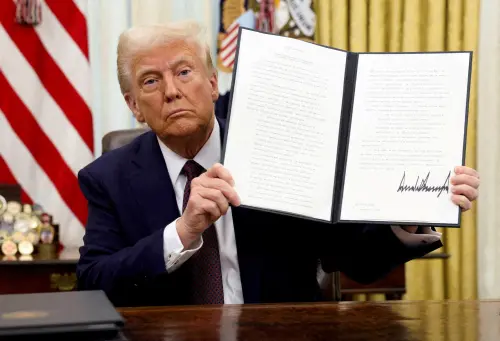The Trump administration’s approach to federalism increasingly entails identifying states that do not embrace its policies and applying executive pressure to bring them to heel. Much like heads of universities and law firms, governors are beginning to get the treatment. This can begin with executive orders that declare broad presidential policy aims but lack specifics on either constitutional or statutory authority, much less procedural detail. A shakedown process can result in targeted institutions being firmly advised to shift course promptly or face serious consequences.
Recent executive orders indicate that this approach is being extended to state energy production and use. An April 8 Protecting American Energy from State Overreach order contends that many state energy policies have imposed “significant barriers to interstate and international trade” and are “fundamentally irreconcilable” with administration objectives to “unleash American energy.” It empowers Attorney General Pam Bondi to work with relevant federal agency heads to identify offensive state energy laws and “expeditiously take all appropriate action to stop” their enforcement. This is intended to work in concert with other recent executive orders, including a quartet designed to reverse declining coal production and use for electricity.
It is not clear how these will be implemented. The state overreach order identifies energy sources that the administration favors (oil, natural gas, coal, hydropower, nuclear, geothermal, and biofuel). But it does not reference other major domestic energy sources, such as wind and solar, seemingly drawing a bullseye on them for heightened scrutiny. It briefly highlights a few policies deemed problematic (cap-and-trade in California and compensation for climate damages from energy production firms in New York and Vermont) but does not confine its scope to these. More broadly, it calls upon the attorney general to prioritize a review of state laws that purport to address such issues as “climate change” or “greenhouse gas” emissions.
The order, however, never explains how this nullification process would be operationalized. Quite aside from massive constitutional and statutory stumbling blocks is the sheer enormity of state policies that have been adopted in this area over the past quarter-century and could conceivably warrant attorney general scrutiny. Every state has achieved some level of decarbonization in its electricity supply since 2000, with some ongoing consequences for now-favored energy sources.
Between 2015 and 2020, a time span including the first Trump administration, more than 400 bills were adopted by states that, in some fashion, supported within-state development of energy sources not included on the executive order’s preferred list. About one-third of these were approved with bipartisan support in states with full Republican control of the executive and legislative branches, including major initiatives in South Carolina, Georgia, and Arkansas. Many states have adopted such policies on state political economy grounds, seeing multiple upsides to home-generated renewables over imported coal or gas. Under the new executive order, many of these could potentially be deemed as threatening new administration objectives, including reduced demand for prioritized domestic energy sources.
Consequently, any serious effort to vet all existing state policies that threaten new executive plans would have to cast a very wide net. A comprehensive review would require platoons of federal government analysts and attorneys, amid aggressive downsizing of federal agency staff. Such a study might well turn up policies offensive to the president but adopted with broad support by states he considers part of his political base. Moreover, the order’s vague brushstrokes on how to conduct this review could generate a staggering set of interpretation and implementation questions.
Would a host of state policies adopted over the past 25 years to shutter coal plants for a range of economic and environmental reasons be deemed contrary to the president’s agenda and thereby warrant repeal? How many of the hundreds of coal-burning units that have been closed during this century should be reopened, and how many currently scheduled for retirement should remain operational? Have states possessing fossil fuel resources that have been reluctant to pursue fracking for oil and gas or mining for coal undermined the national interest, and now must be required to atone by pursuing production? Should state legislation designed to thwart federal installation of interim (Texas and New Mexico) or permanent (Nevada) nuclear waste repositories be overturned since they might imperil future nuclear power expansion? Would states that have taken major steps to reduce methane waste during oil and gas production be required to abandon them to incentivize greater output? Do the numerous oil and gas production states that apply severance taxes to extracted energy, imposing cost burdens commonly shifted to consumers in other states, burden interstate commerce and reduce fossil fuel demand, as was hotly debated in Congress in the 1980s?
The full implications of this new search-and-destroy approach to energy federalism are difficult to fathom. From recent administration experience, one can assume that implementation of this executive order will lead to a form of executive branch shakedown applied initially to high-profile state cases and then expanded, backed by threats to terminate federal funding and double down on regulatory pressures.
The United States is decades overdue for a serious conversation about clarifying the roles of federal and state government in developing effective energy and environmental policy for the next quarter-century. But the latest string of executive orders suggests continued movement toward a new era of federalism that borrows from Tammany Hall rather than the Federalist Papers.
The Brookings Institution is committed to quality, independence, and impact.
We are supported by a diverse array of funders. In line with our values and policies, each Brookings publication represents the sole views of its author(s).






Commentary
Shakedown federalism and energy policy nationalization
April 21, 2025